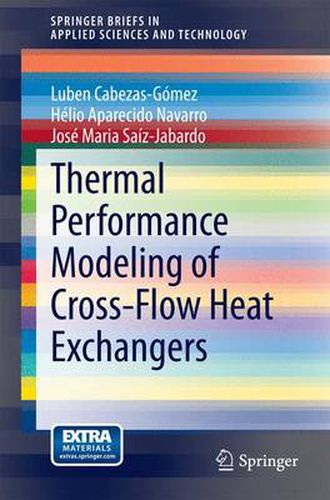Readings Newsletter
Become a Readings Member to make your shopping experience even easier.
Sign in or sign up for free!
You’re not far away from qualifying for FREE standard shipping within Australia
You’ve qualified for FREE standard shipping within Australia
The cart is loading…






This title is printed to order. This book may have been self-published. If so, we cannot guarantee the quality of the content. In the main most books will have gone through the editing process however some may not. We therefore suggest that you be aware of this before ordering this book. If in doubt check either the author or publisher’s details as we are unable to accept any returns unless they are faulty. Please contact us if you have any questions.
This monograph introduces a numerical computational methodology for thermal performance modeling of cross-flow heat exchangers, with applications in chemical, refrigeration and automobile industries. This methodology allows obtaining effectiveness-number of transfer units (e-NTU) data and has been used for simulating several standard and complex flow arrangements configurations of cross-flow heat exchangers. Simulated results have been validated through comparisons with results from available exact and approximate analytical solutions. Very accurate results have been obtained over wide ranges of NTU and C* values in all cases. The proposed procedure constitutes a useful research tool for both theoretical and experimental studies of cross-flow heat exchangers.
The following are the unique features of the book:
The monograph includes the computational code named HETE (Heat Exchanger Thermal Effectiveness) in Chapter 5. A version of this code is available for downloading.
The computational procedure could be used for reducing experimental data using the effectiveness - NTU (e-NTU) method in research and industrial laboratories.
Even after more than one century in heat exchanger research, the search for new flow arrangements with higher effectiveness still is an unsolved problem. The present methodology could be a useful tool in pursuing that goal.
$9.00 standard shipping within Australia
FREE standard shipping within Australia for orders over $100.00
Express & International shipping calculated at checkout
This title is printed to order. This book may have been self-published. If so, we cannot guarantee the quality of the content. In the main most books will have gone through the editing process however some may not. We therefore suggest that you be aware of this before ordering this book. If in doubt check either the author or publisher’s details as we are unable to accept any returns unless they are faulty. Please contact us if you have any questions.
This monograph introduces a numerical computational methodology for thermal performance modeling of cross-flow heat exchangers, with applications in chemical, refrigeration and automobile industries. This methodology allows obtaining effectiveness-number of transfer units (e-NTU) data and has been used for simulating several standard and complex flow arrangements configurations of cross-flow heat exchangers. Simulated results have been validated through comparisons with results from available exact and approximate analytical solutions. Very accurate results have been obtained over wide ranges of NTU and C* values in all cases. The proposed procedure constitutes a useful research tool for both theoretical and experimental studies of cross-flow heat exchangers.
The following are the unique features of the book:
The monograph includes the computational code named HETE (Heat Exchanger Thermal Effectiveness) in Chapter 5. A version of this code is available for downloading.
The computational procedure could be used for reducing experimental data using the effectiveness - NTU (e-NTU) method in research and industrial laboratories.
Even after more than one century in heat exchanger research, the search for new flow arrangements with higher effectiveness still is an unsolved problem. The present methodology could be a useful tool in pursuing that goal.